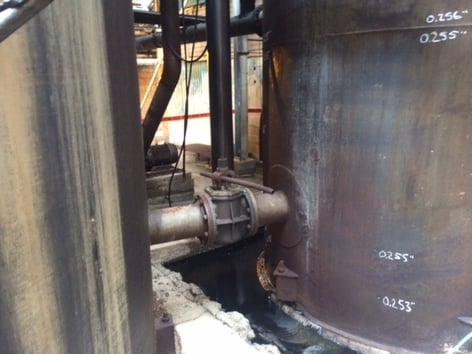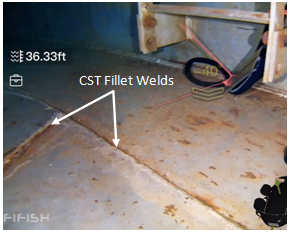Comprehensive Overview to Tank Welding Inspection for Security and Quality
Comprehensive Overview to Tank Welding Inspection for Security and Quality
Blog Article
A Comprehensive Introduction of Container Welding Inspection Specifications and Methodologies for Improved Weld Top Quality and Performance
The value of welding assessment standards in the production of containers can not be overstated, as they offer as the foundation for ensuring weld integrity and operational reliability. Various assessment methods, including visual assessments and advanced non-destructive testing methods, are essential in determining possible defects that can endanger performance.
Significance of Welding Examination Standards

Welding assessment criteria include a variety of requirements, consisting of product specifications, welding treatments, and credentials of personnel entailed in the welding process. By imposing these criteria, organizations can methodically determine and rectify possible flaws, thus lowering the probability of costly repair services or tragic failures. Furthermore, rigorous evaluation techniques foster a society of liability and precision, encouraging welders to preserve high degrees of workmanship.

Typical Welding Examination Strategies


Ultrasonic Examining (UT) is one more prevalent technique, making use of high-frequency acoustic waves to discover internal imperfections that might not be visible externally. This approach is especially effective for recognizing spaces or inclusions within the weld steel. Magnetic Bit Testing (MT) is additionally commonly used, particularly for ferromagnetic materials, as it discloses surface and near-surface defects with the application of magnetic fields and ferrous fragments.
Furthermore, Liquid Penetrant Screening (PT) spots surface-breaking issues by applying a penetrant to the weld and afterwards using a designer to attract out the penetrant. Each of these methods contributes to a thorough evaluation approach, making sure that welds meet the rigid quality requirements required in storage tank building and construction.
Regulative Requirements and Compliance
Regulative criteria and compliance are crucial components in making sure the safety and dependability of bonded structures in storage tank building and construction - Tank Welding Inspection. These standards offer to develop minimum requirements for product residential or commercial properties, welding treatments, and examination practices, consequently lowering the risk of architectural failings and boosting overall performance
Trick companies, such as the American Society of Mechanical Engineers (ASME) and the American Welding Culture (AWS), supply standards that are widely embraced in the market. Discover More Here Compliance with these criteria not only guarantees adherence to finest practices however additionally meets legal and legal obligations, safeguarding the rate of interests of stakeholders.
Regulative bodies often mandate adherence to particular codes, such as ASME Code Area IX for welding qualifications and API 650 for welded storage tanks. These codes describe demands for welding strategies, credentials of employees, and screening approaches to verify weld integrity.
Regular audits and evaluations are vital to preserving compliance, as they assist determine variances from established requirements. Non-compliance can lead to considerable charges, project delays, and safety hazards. Thus, a durable understanding of governing criteria and a dedication to compliance are critical in achieving top quality and resilient welded tank frameworks.
Non-Destructive Checking Techniques
Exactly how can the integrity of welded frameworks be guaranteed without triggering damage? Non-destructive screening (NDT) approaches provide a robust solution, making it possible for assessors to assess weld quality without compromising the product - Tank Welding Inspection. Among the most usual NDT methods are ultrasonic testing (UT), radiographic screening (RT), magnetic bit testing (MT), and color penetrant screening (PT)
Radiographic testing entails passing X-rays or gamma rays through the weld, developing images that disclose architectural issues such as splits or gaps. This method is very useful for evaluating the honesty of complicated welds.
Magnetic fragment testing is fit for ferromagnetic materials, where electromagnetic fields expose surface area and near-surface suspensions. Dye penetrant testing utilizes a fluid dye to highlight surface-breaking flaws, making it a discover this reliable technique for non-porous products.
Each of these NDT methods has unique benefits, enabling detailed analyses tailored to certain products and welding processes. By carrying out these strategies, industries can make sure the integrity and safety of welded frameworks, inevitably enhancing overall performance.
Enhancing Weld Top Quality Through Evaluation
Efficient assessment plays a crucial role in improving weld high quality, acting as a vital checkpoint in the fabrication process. By determining prospective issues early, examinations mitigate the risk of my latest blog post compromised structural stability and make sure conformity with sector criteria. Using a mix of visual assessments, non-destructive screening (NDT) techniques, and mechanical evaluations, examiners can find concerns such as porosity, splits, and insufficient combination.
Carrying out a durable assessment procedure not only improves the overall quality of welds yet additionally cultivates a society of liability amongst welders and producers. Routine training and accreditation of evaluation personnel ensure that they are equipped with the essential abilities to acknowledge and deal with potential problems properly. This aggressive technique reduces rework and associated prices, inevitably adding to project efficiency.
In addition, detailed paperwork of inspection searchings for supplies important insights right into repeating issues, promoting constant improvement in welding techniques. By leveraging sophisticated technologies, such as automated ultrasonic screening or digital radiography, weld quality can be boosted through extra exact assessments. Finally, an extensive inspection procedure is essential in attaining top notch welds, guaranteeing safety and security, dependability, and long life in storage tank manufacture.
Final Thought
Finally, the application of strenuous storage tank welding examination requirements and techniques is vital for ensuring weld stability and efficiency. By utilizing a mix of aesthetic evaluations, non-destructive screening methods, and adherence to regulative criteria, organizations can successfully recognize and reduce possible defects. Promoting a society of accountability among welders additionally boosts the quality of welding procedures. Eventually, these methods add to lowered structural failures, reduced repair service prices, and improved operational efficiency within the market.
Report this page